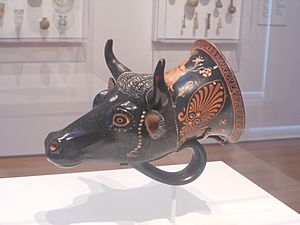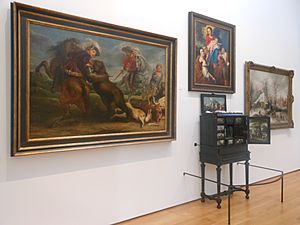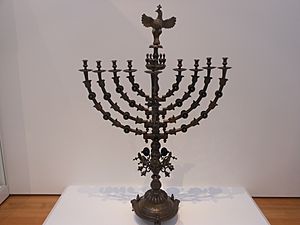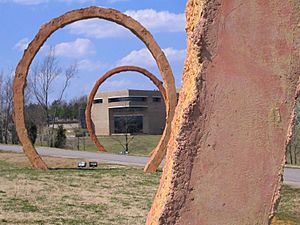North Carolina Museum of Art facts for kids
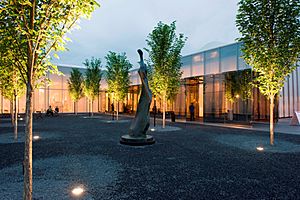
West Building entrance canopy
|
|
| Established | 1947 |
|---|---|
| Location | 2110 Blue Ridge Road, Raleigh, NC 27607 |
The North Carolina Museum of Art (NCMA) is a cool art museum located in Raleigh, North Carolina. It first opened its doors in 1956. What makes it special is that it was the first big museum in the United States to be started and funded by a state government.
Since 1947, when the state first set aside money for its art collection, the NCMA has offered free admission to its main collection. This means everyone can enjoy amazing art! The museum has a huge collection of art that covers more than 5,000 years of history. You can see everything from ancient times to modern art.
The NCMA also has an outdoor amphitheater for shows and lots of exciting exhibitions and programs. Inside, there are over 40 galleries to explore. Outside, there's a massive 164-acre (0.66 km2) park with many large artworks. This makes it one of the biggest museum parks in the country! The NCMA is one of the top art museums in the American South. It recently finished a big expansion that won awards for its smart, energy-saving design.
Contents
History of the NCMA: How It Started
Early Beginnings and First Collections
In 1924, a group called the North Carolina State Art Society formed. They wanted to create an art museum for the state. By 1928, they had raised enough money. In 1929, 75 paintings were shown in temporary spaces in the Agriculture Building in Raleigh. Later, in 1939, the NCMA moved to the old Supreme Court building.
In 1947, the state government did something amazing. They set aside $1 million to buy art for the people of North Carolina. This money was used to buy 139 European and American artworks. The Samuel H. Kress Foundation also gave a gift of 71 artworks, mostly from the Italian Renaissance. This was the first time a U.S. state had ever set aside money specifically for an art collection. Alice Willson Broughton, who was the former First Lady of North Carolina, helped get this funding.
Opening at Morgan Street
On April 6, 1956, the museum officially opened. It was located in a renovated building on Morgan Street in downtown Raleigh. W. R. Valentiner became the museum's first director. Ben Williams was the first curator. In 1961, the state government made the museum a separate state agency. This meant it was managed by both the state and a group of trustees. Ten years later, the NCMA became part of what is now the North Carolina Department of Natural and Cultural Resources.
Moving to Blue Ridge Road
By 1967, the museum had grown too big for its Morgan Street home. A new location was chosen on Blue Ridge Road. The new building was designed by Edward Durrell Stone and Holloway-Reeves Architects. It opened in 1983. Stone used square shapes as a basic design idea for the entire museum. This was Stone's last big design before he passed away. After he died in 1978, the outside of the building was changed from white marble to red brick.
Modern Expansion and New Buildings
In April 2010, the museum opened its new West Building. This huge building is 127,000 square feet (11,800 m2). It was designed by Thomas Phifer and Partners. The West Building is surrounded by sculpture gardens and pools. It was built to show off the museum's main collection. It also features over 100 new artworks bought for the expansion.
Some highlights include 30 sculptures by Auguste Rodin. There are also works by artists like Roxy Paine, Ursula von Rydingsvard, El Anatsui, Jaume Plensa, Jackie Ferrara, Ellsworth Kelly, and David Park. The project also changed the museum's East Building. It became a place for temporary exhibitions, education, public events, and offices. The whole project cost $72.3 million. The West Building's outer walls are covered with special aluminum panels. The roof lets in natural light through unique, curved openings.
Amazing Art Collections
The museum's main collection has many different types of art. You can see European paintings from the Renaissance to the 1800s. There's also Egyptian art, sculptures and vase paintings from ancient Greece and Rome. You'll find American art from the 1700s to the 1900s. And there's lots of international contemporary art (art from today). Other cool parts of the collection include art from Africa, ancient America, pre-Columbian times, and Oceanic art. There are also special Jewish ceremonial objects.
African Art Collection
The museum's African art collection started in the 1970s. It includes historical pieces from the 1800s and 1900s. Some important items are from the Benin Kingdom. Later, the collection grew to include art from other parts of sub-Saharan Africa. The goal was to show works that had a special style from certain groups, like the Chokwe and Luba peoples of central Africa. Many pieces are made from traditional materials like wood, metal, and fabric. Even though many are old, some works from the mid-1900s show how different cultures have shared ideas for centuries.
American Art Collection
The American art collection has paintings and sculptures from the mid-1700s to the early 1900s. It starts with three large portraits by John Singleton Copley. It ends with paintings by leading American impressionists. The collection shows many important ideas in American art history. These include celebrating nature and finding a national identity. It also shows conflicts over race, immigration, and social class. It highlights how society quickly changed from a farming country to an industrial powerhouse. In December 2018, the museum added the 1865 sculpture Saul by William Wetmore Story.
Ancient American Art
The ancient American collection features art from three different areas. These are Mesoamerica, Central America, and the Andes. The ancient American gallery mainly focuses on Mesoamerica. It especially highlights the art of the ancient Maya. The Maya were known for their achievements in science and art. They were very powerful in their region for almost two thousand years. The museum's collection shows their religious beliefs, sports, rituals, and daily life.
Egyptian Art Collection
The ancient Egyptian art collection has 38 artifacts. But it represents all the major periods of ancient Egyptian history. This includes the Predynastic period (4000–3500 BCE) to the Roman period (30 BCE – 642 CE). The oldest item is a black-topped red ceramic jar. It was made about 6,000 years ago. The collection is strong in items related to funerals. These include painted coffins, statues for chores in the afterlife (called shabtis), and a canopic jar. This jar once held the mummified liver of a man named Qeny. Other parts of the collection show the many gods Egyptians worshipped.
European Art Collection
The museum's European collection is one of its strongest. Out of the 139 paintings and sculptures bought with the first state money, 123 were European. In 1961, the Samuel H. Kress Foundation gave 75 more Italian paintings and sculptures. These additions made the European collection one of the best in the United States. The gallery mainly shows paintings like Virgin and Child in a Landscape by Cima da Conegliano. It also has many important sculptures. This includes over 30 bronze pieces by Auguste Rodin. Some of these are in the museum's Rodin Garden.
British, Spanish, and French Art (Post-1600)
The museum has several British portraits. Most of these are in a gallery about European portraits and early American ones. The collection includes important works by Paul van Somer, Anthony van Dyck, Francis Cotes, Sir William Beechey, Thomas Gainsborough, and Sir Henry Raeburn. The museum's French and Spanish collections have paintings by Murillo. There are also portraits and still lifes by Boudin, Millet, Pissarro, and Monet.
Italian Art Collection
The museum's collection of Italian paintings is very impressive. Highlights include a gallery just for altarpieces and religious works from the 1500s to the 1700s. There are also paintings by famous artists like Titian and Raphael. You can also see 17th-century baroque art.
Northern European Art Collection
The Northern European collection is small but special. It has important Northern Renaissance paintings and sculptures. There's also a significant collection of 17th-century Dutch and Flemish paintings. A Flemish baroque kunstkamer (a room filled with art and interesting objects) is also featured. The 17th-century Dutch and Flemish collections are larger. They include works by Hendrick Ter Brugghen, Jan Steen, Jan Lievens, Jacob van Ruisdael, and Govaert Flinck. You'll also find art by Jan Brueghel the Elder, Peter Paul Rubens, Gerard Seghers, Anthony van Dyck, Jacob Jordaens, and Frans Snyders.
Modern Art (Up to 1960)
In the West Building, the museum's modern art collection fills several rooms. It features works by top German modern artists from the early 1900s. These include Franz Kline and Lyonel Feininger. You'll also see early American modernists like Alberto Giacometti. The collection has Cubist and Surrealist pieces by Paul Delvaux and Joseph Cornell. Other modern masters like Richard Diebenkorn, Andrew Wyeth, and Alberto Giacometti are also on display.
Judaic Art Collection
The museum's Judaic art collection celebrates the spiritual life and ceremonies of the Jewish people. It features beautiful ritual objects. This is one of only two galleries in an American art museum dedicated to Judaica. The Judaic Art Gallery shows objects from the main Jewish traditions. These include Ashkenazi, Sephardi, and Mizrahi traditions. It also has art from modern Israel. All the objects are made for use in synagogue worship. They are also used for Sabbath and holiday observances. Or for special life events and Jewish homes. Examples include a Menorah and Torah scrolls.
Contemporary Art Collection
In recent years, the museum has bought many new artworks. This has built a strong collection of contemporary art. They have worked hard to get art in new and experimental forms. Examples include Bill Viola’s video The Quintet of Remembrance (2000). Another is Michal Rovner’s video installation Tfila (2004). The museum has also added works by artists from many different backgrounds. In 2003, the museum started collecting contemporary photography. By 2010, the collection had over 200 photos. These were by national and international photographers. They included works by Rosemary Laing, Dinh Q. Lê, Vera Lutter, and Lorna Simpson. Recent additions include works by Hank Willis Thomas, Kehinde Wiley, and Mickalene Thomas.
Two identical sculptures, called Spiegel I and Spiegel II, are in the museum's garden. They are made of white painted stainless steel. The Spanish sculptor Jaume Plensa created them in 2010. The collection also includes a wide range of art by North Carolina artists.
Museum Park: Art Outdoors
The Museum Park covers 164 acres (0.66 km2) of fields, woodlands, and creeks. It features more than a dozen artworks made specifically for their outdoor locations. There are also two miles (3 km) of trails to explore. This campus is one of the largest museum art parks in North America. In warmer months, outdoor movies and concerts used to be held at the Joseph M. Bryan, Jr., Amphitheater. However, as of August 2025, the Amphitheater is under construction. It will not host any outdoor movies or concerts in 2025 and 2026.
The museum's contemporary art program extends into the landscape around the museum. Artists have created both temporary and permanent artworks in the Museum Park. As of 2010, art in the Park includes works by Thomas Sayre and Vollis Simpson. You can also see art by Martha Jackson-Jarvis and Ledelle Moe. There's also a camera obscura called Cloud Chamber for the Trees and Sky by Chris Drury. Other outdoor sculptures are also installed in the gardens around the West Building. These include Ronald Bladen's Three Elements and Henry Moore's Large Spindle Piece and Large Standing Figure: Knife Edge. Picture This is part of the museum's amphitheater. It is a huge artwork designed by artist Barbara Kruger with architects and landscape architects.
Exhibitions: What's On Display
Since the renovations in 2010, the East Building has hosted many changing exhibitions. These include a gallery for North Carolina artists and a photography gallery. There are also educational exhibitions. Plus, at least two traveling or temporary exhibitions are always on display.
Past Exhibitions to Explore
- Word Up: The Intersection of Text and Image, July 22, 2012–January 20, 2013
- Project 35, August 19, 2012–June 2, 2013
- Edvard Munch: Symbolism in Print, September 23, 2012–February 10, 2013
- Still-Life Masterpieces: A Visual Feast from the Museum of Fine Arts, Boston, October 21, 2012–January 13, 2013
- John James Audubon’s The Birds of America, November 7, 2010–ongoing
- A Discerning Eye: Julian T. Baker Jr. Photography Collection, June 17, 2012–December 2, 2012
- Rhythms of the Heart: The Illustration of Ashley Bryan, April 15, 2012–August 19, 2012
- Reflections: Portraits by Beverly McIver, December 11, 2011–June 24, 2012
- Rembrandt in America, October 30, 2011–January 22, 2012
- Mirror Image: Women Portraying Women, June 5–November 27, 2011
- Presence/Absence, November 27, 2011–May 27, 2012
- 30 Americans: Contemporary African American Art Collection from the Rubell Family, March 19, 2011-September 4, 2011
- Alter Ego: A Decade of Work by Anthony Goicolea, April 17–July 24, 2011
- American Chronicles: The Art of Norman Rockwell, November 7, 2010–January 30, 2011
- Bob Trotman: Inverted Utopias, November 7, 2010–March 27, 2011
- Fins and Feathers: Original Children’s Book Illustrations from The Eric Carle Museum of Picture Book Art, November 7, 2010–January 30, 2011
- Julie Mehretu: City Sitings, August 17–November 30, 2008
- Far from Home, February 17–July 13, 2008
- Landscapes from the Age of Impressionism, October 21, 2007–January 20, 2008
- The BIG Picture, March 18, 2007–September 2, 2007
- Temples and Tombs: Treasures of Egyptian Art from The British Museum, April 14–July 8, 2007
- Contemporary North Carolina Photography from the Museum's Collection, First rotation: September 3–November 5, 2006, Second rotation: November 19, 2006–February 18, 2007
- Revolution in Paint, September 17, 2006–February 11, 2007
- Monet in Normandy, October 15, 2006–January 14, 2007
- Common Ground: Discovering Community in 150 Years of Art, Selections from the Collection of Julia J. Norrell, May 7–July 16, 2006
- Sordid and Sacred: The Beggars in Rembrandt's Etchings: Selections from the John Villarino Collection, March 5–May 28, 2006
- The Potter's Eye: Art and Tradition in North Carolina Pottery, October 30, 2005–March 19, 2006
- Crosscurrents: Art, Craft, and Design in North Carolina, September 25, 2005–January 8, 2006
- Shadow Boxes: Collages of Experience and Memory, August 15–December 11, 2005
- Fusion: Contemporary Glass Art from North Carolina Collections, May 8–August 7, 2005
- In Focus: Contemporary Photography From The Allen G. Thomas Jr. Collection, April 3–July 17, 2005
- Objects of Desire: The Museum Collects, 1994–2004, Ended March 2, 2005
- Matisse, Picasso and the School of Paris: Masterpieces from The Baltimore Museum of Art, October 10, 2004–January 16, 2005
- American Eden: Landscape Masterworks of the Hudson River School: From the Collection of the Wadsworth Atheneum Museum of Art, June 6–August 29, 2004
- Brushes With Life: Art, Artists and Mental Illness, Ended August 15, 2004
- Defying Gravity: Contemporary Art and Flight, November 2, 2003–March 7, 2004
- Augustus Saint-Gaudens: American Sculptor of the Gilded Age, February 23–May 11, 2003
- Accent of Africa, April 6–August 10, 2003
- In Memoriam: George Bireline (1923–2002), December 18, 2002–August 3, 2003
- Art in the Age of Rubens and Rembrandt, October 13, 2002–January 5, 2003
- Selections from The Birds of America by John James Audubon, July 14–December 1, 2002
- The Reverend McKendree Robbins Long: Picture Painter of the Apocalypse, April 7–August 25, 2002
- Empire of the Sultans: Ottoman Art from the Khalili Collection, May 19–July 28, 2002
- Toulouse-Lautrec: Master of the Moulin Rouge from the Collection of The Baltimore Museum of Art, November 11, 2001–February 17, 2002
- Picasso, Braque, Léger: Paintings from the Collection of Mr. and Mrs. Julian H. Robertson, June 10–September 9, 2001
- Xu-Bing: Reading Landscape, April 29–August 5, 2001
- Stanton Macdonald-Wright and Synchromism, March 4–July 1, 2001
- Is Seeing Believing, January 14– April 1, 2001
- Ansel Adams, October 8, 2000–January 7, 2001
- Rodin, April 16–August 13, 2000
- Alphonse Mucha: The Spirit of Art Nouveau, January 31–March 28, 1999
- Sinners and Saints, Darkness and Light: Caravaggio and His Dutch and Flemish Followers, September 27–December 13, 1998
- Closing: The Life and Death of an American Factory, Photographs by Bill Bamberger, July 26–October 18, 1998
See also
- List of contemporary amphitheatres


